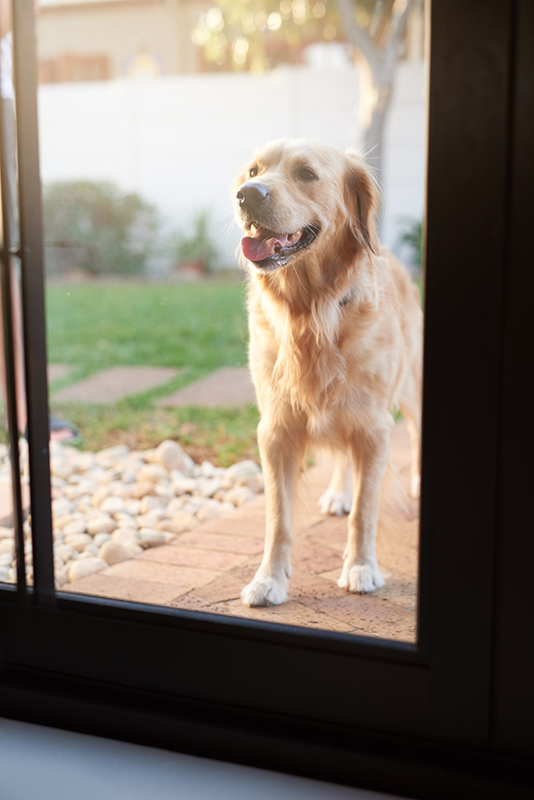Barking Dogs and Delayed Reinforcement
 Not too many years ago we had a wonderful Golden Retriever named Molly, whose greatest pleasure in life was human contact. Sure, she would step outside in the morning for a quick relief, but within seconds post-relief she was barking in hopes the door would open (did I say that?) and she would be reunited with her humans. The yipping, barking dog outside longing to be inside is one of the most common complaints I hear from such dogs’ humans. Never mind the neighbors next door! It is obvious that yipping, barking dogs do so because such behavior is reinforced by immediately being given access to the house. Doing so shuts up both the dog and the yipping barking (at you) neighbors. I didn’t want Molly to do this, but I did appreciate the bark letting me know she was ready to reenter her castle.
Not too many years ago we had a wonderful Golden Retriever named Molly, whose greatest pleasure in life was human contact. Sure, she would step outside in the morning for a quick relief, but within seconds post-relief she was barking in hopes the door would open (did I say that?) and she would be reunited with her humans. The yipping, barking dog outside longing to be inside is one of the most common complaints I hear from such dogs’ humans. Never mind the neighbors next door! It is obvious that yipping, barking dogs do so because such behavior is reinforced by immediately being given access to the house. Doing so shuts up both the dog and the yipping barking (at you) neighbors. I didn’t want Molly to do this, but I did appreciate the bark letting me know she was ready to reenter her castle.
Now, I am one who knows a little something about delay of reinforcement, having spent a good chunk of my adult life studying it in the laboratory with pigeons and rats. One of the things I have learned is that an animal with no history of making a specified response (e.g., a peck on a pigeon key) learn to do so with absolutely no training of the response at all. Put a motivated animal in a situation where dinner can be had by making a response like a key peck, wait long enough (in the case of pigeons I have waited as much as 8 hours – not an efficient way to establish new behavior, but it does work reliably), and voila, the response occurs. And here’s the really interesting part. Let’s say that the required response is made. Once it happens, nothing – absolutely nothing – occurs for, say, 30 seconds following that response. At that point, however, and barring the occurrence of another such response during the 30-second period, food is delivered and the pigeon can eat for a predetermined time period. After that, it has to make another response and then wait 30 seconds for the next food delivery. No food delivery occurs without a response, and no response is followed by food unless there is a 30-second period without a response following the one that starts the delay. Pigeons, rats, Siamese fighting fish, zebrafish, and people all learn to make a new response when reinforcement is delayed in this manner. The procedure is technically labeled a resetting unsignaled delay, but that detail is provided only for any lab nerds (like me) out there.
So what does this have to do with Molly ‘n me? As I said, I found Molly’s bark useful. When I let her out I didn’t have to hang around the door waiting for her to finish her tasks and t hen let her in. I could let her out, go about my own morning chores, wait to her bark, then go and let her in. Except if I did that, I knew, I would end up with the yipping barking monster that is the dog next door. Instead, I drew on what I have learned about delayed reinforcement, where the response is maintained, but at very low rates compared to that maintained by immediate reinforcement.
hen let her in. I could let her out, go about my own morning chores, wait to her bark, then go and let her in. Except if I did that, I knew, I would end up with the yipping barking monster that is the dog next door. Instead, I drew on what I have learned about delayed reinforcement, where the response is maintained, but at very low rates compared to that maintained by immediate reinforcement.
Molly would bark. I would start counting at a 1-second pace (1001 … 1002 … you get the picture) to myself. If Molly barked again after the first bark, I would reset the count and start over. If I reached 30 seconds without a second bark in the period, I would open the door and greet her with wild enthusiasm (for you fans of Peanuts, imagine Snoopy in his happy mode), which she would, without fail, reciprocate (else why would I do it? Her behavior maintained mine as much as mine maintained hers).
My little delay of reinforcement procedure with Molly worked like magic. She would go out, visit her favorite spots, return to the door, bark once and then wait patiently. If I didn’t hear her bark the first time, she would bark again – typically once- and then wait again. I tried not to miss her first or second bark because I knew I had a good thing going with her and didn’t want this behavior to extinguish.
This is a very easy solution whenever there is some behavior that is useful or desirable, but only if it occurs infrequently, that is, at low rates. It’s a far simpler and more practical solution to dogs barking “to be let in” than a doggie doorbell or, for me, even a doggie door (which lets in cold air and raccoons, at least where I live). Give it a try and let me know if it works for you as it did for me.




